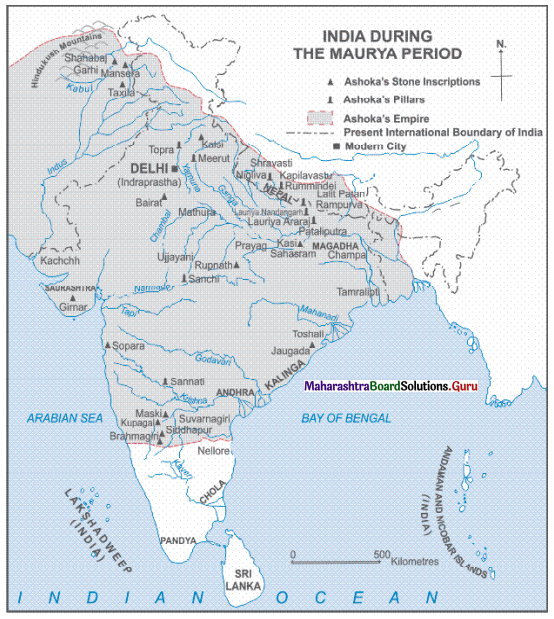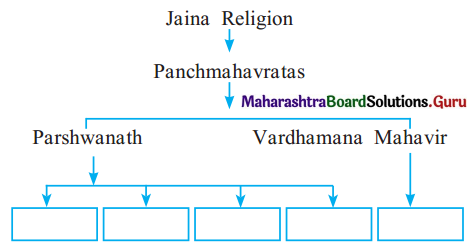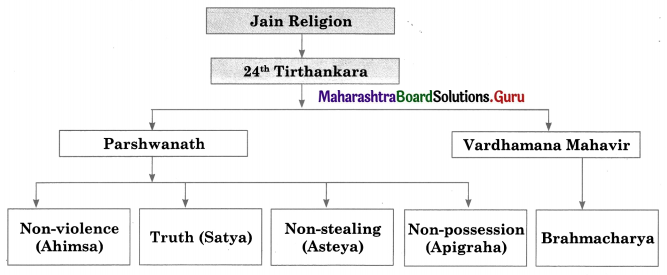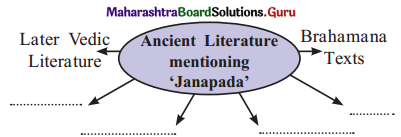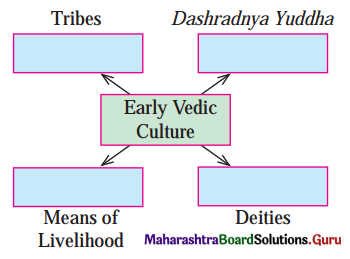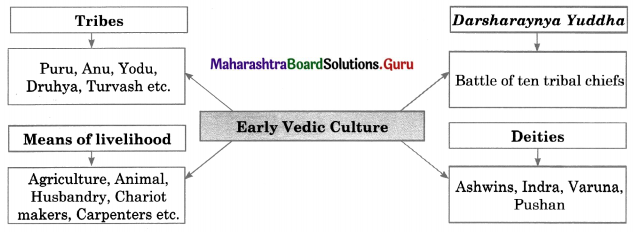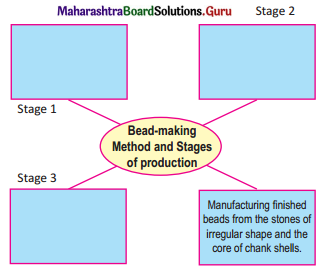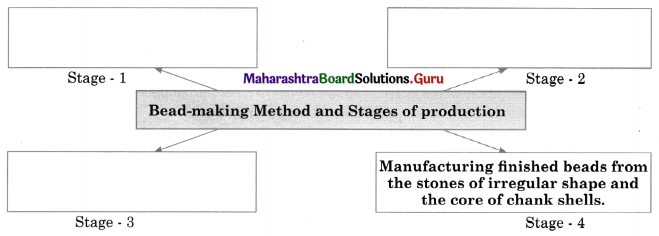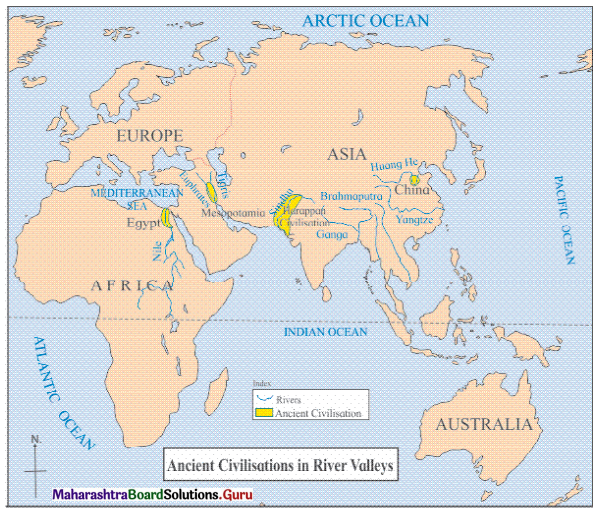Std 11 History Chapter 10 Question Answer Changing Times Maharashtra Board
Balbharti Maharashtra State Board Class 11 History Solutions Chapter 10 Changing Times Textbook Exercise Questions and Answers.
Class 11 History Chapter 10 Changing Times Question Answer Maharashtra Board
History Class 11 Chapter 10 Question Answer Maharashtra Board
1A. Choose the correct alternative and write complete sentences.
Question 1.
The history of Indo-Greeks is known through their _____________
(a) literature
(b) inscription
(c) coins
(d) pottery
Answer:
(c) coins
Question 2.
Gupta dynasty was founded by _____________
(a) Sri Gupta
(b) Ghatotkach
(c) Samudragupta
(d) Ramgupta
Answer:
(a) Sri Gupta
![]()
Question 3.
After accession by defeating the Shakas _____________ took up the title of ‘Vikramaditya’.
(a) Chandragupta II
(b) Ramgupta
(c) Chandragupta I
(d) Kumaragupta
Answer:
(a) Chandragupta II
1B. Find the incorrect pair from set B and write the correct ones.
Question 1.
| Set ‘A’ | Set ‘B’ |
| (a) Kshaum | Linen Cloth |
| (b) Pushpaptta | Cotton Cloth |
| (c) Dukul | Silk Cloth |
| (d) Amshuka | Muslin Cloth |
Answer:
(b) Pushpatta – Floral designs
2. Explain the following statements with reasons.
Question 1.
During the Gupta period, the power was concentrated in the hands of local landlords.
Answer:
- During the Gupta period, lands were granted to civil and military officers instead of salaries.
- The roots of the feudal system can be found in this period.
- It is believed that the feudal economy brought about the decline of urban centers.
- Because of revenue tax exemption on the donated land, the revenue too decreased and the royal treasury was depleted.
- It was concentrated in the hands of locals’ landlords. Because of this the king no longer remained in the center of power.
Question 2.
Every tide of the Huna invasion made the Gupta rule weaker.
Answer:
- During the period of Kumargupta son of Chandragupta II, the Huna in India began.
- Kumargupta withheld the attacks of Hunas.
- After Kumargupta, the succeeding kings proved to be incapable of protecting their kingdom.
- Finally, the Gupta empire disintegrated into many and small kingdoms.
3. State your opinion.
Question 1.
Samudragupta performed the Asvamedha sacrifice after Digvijaya.
Answer:
- Samudraguptas ambition was to rule entire India as a unified empire.
- Samudragupta first conquered neighbouring kingdoms.
- After the conquest in the North, he carried out an expedition in the south to conquer the southern kingdoms. The rulers of the regions beyond this conquered area became his feudatories.
- He made them accept his suzerainty.
- After this conquest (Digvijay) Samudragupta performed the Ashwamedha Sacrifice and proclaimed himself as Chakravarti king.
![]()
4. Write short notes.
Question 1.
Gupta Sculptures
Answer:
- The human figure was the central theme of the sculptures in the Gupta period.
- Human sculptures and images of deities were created during this period.
- Sculptures belonging to this period are found at many places such as Sarnath, Devgadh, Ajanta.
- During this period, Hindu, Buddhist, and Jain religious icons were made of stone, metals, and terracotta.
Question 2.
Indo-Roman trade
Answer:
- The Periplus of Erythrean Sea written in the mid 1st century C.E mentions the Red sea and the sea routes connecting coastal lines, ports, provinces, goods exchanged in trade.
- Items like textiles, black pepper, precious stones, ivory, and animals such as monkeys, parrots, and peacocks for entertainment were exported from India.
- Gold coins were the medium of exchange. Coral and liquor were items of import.
- A large amount of these gold coins found in south India gives an extent of the trade.
- The growing trade between Rome and India saw the rise of several markets and cities.
- Ter, Nevasa, Bhokardan were some of the places where commodities were stored.
- The port of Sopara and Kalyan were important centers of Indo-Roman trade.
5. Answers the following questions with the help of given points.
Question 1.
How did the standardization in various sections during the Gupta period take place?
(a) Division of Gupta administration
(b) Changes in economic structure economy of agriculture
(c) Development of Gupta coinage.
Answer:
(a) Division of Gupta Administrations:
- During the Gupta period, the king was the center of administration. The Prince, Amatya (ministers), and advisors helped him. Many times, the prince was appointed as viceroy who looked after the provincial administration.
- Every province was subdivisions These subdivisions were called Vishaya There was an independent administrator appointed to these Visayas. They were known as ‘Vishayapath’.
- ‘Kumaramatya’ were the provincial officers and ‘Ayuktak’ were the officials who looked after the affairs of the districts.
- Gupta’s administration was decentralized. Many decisions were taken.
![]()
(b) Changes in the economic structure, economy of agriculture:
- The economic structure of the agricultural system was changed by the Gupta kings.
- They preferred giving land to local farmers for tilling. Land donations were also made for the cause of religion and learning. These lands were tax-free.
- They were called Agraharas
- The civil and military officers were granted land grants instead of salaries. Because of revenue tax exemption on the donated land.
- The power was concentrated on the local landlord
- Sugarcane and wheat were cultivated in the northwest province of the Gupta empire while the rice was cultivated in Magadha and eastern regions.
(c) Development of Gupta Coinage:
- Gold Smiths enjoyed a high social status in this period.
- The gold coins are excellent examples of their skills.
- The beautiful and realistic portrayal of various aspects of the king is the characteristic of Gupta Coins.
Activity
Collect more information about ‘Harshacharita’ written by Banabhatta, with the help of the internet.
Answer:
- ‘Harshacharita’ is a biography of Indian Emperor Harsha by Banabhatta also known as Bana, who was a Sanskrit writer of seventh century C.E., India.
- This work is in Sanskrit. It has been categorized as an akhyayika (legend), a romanticized yet historical account.
- Harshacharita has been written in a florid and fanciful style.
- Bana has in detail and vividly described rural India’s natural environment as well as the extraordinary industry of the Indian people.
- This work presents the emperor’s actions in an overly favourable light.
Maharashtra State Board Class 11 History Textbook Solutions
- India During Mauryan Period Class 11 History Textbook Solutions
- Post Mauryan India Class 11 History Textbook Solutions
- Changing Times Class 11 History Textbook Solutions
- Kingdoms in South India Class 11 History Textbook Solutions
- India, Nations in the Northwest of the Indian Subcontinent a Class 11 History Textbook Solutionsnd China
- India, Sri Lanka and Southeast Asia Class 11 History Textbook Solutions
- Delhi Sultanate, Vijayanagar and Bahamani Kingdom Class 11 History Textbook Solutions
- India During Mughal Period Class 11 History Textbook Solutions
- Swarajya to Empire (Maratha Period) Class 11 History Textbook Solutions
